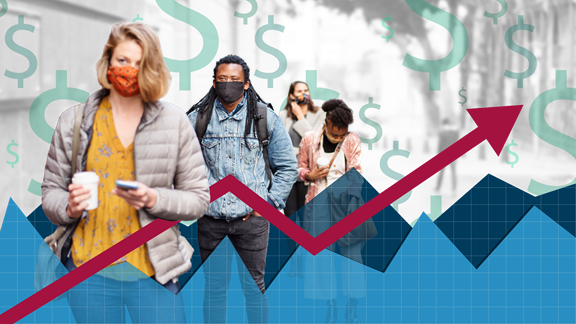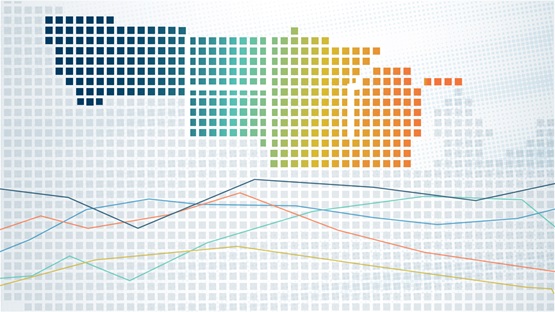The unemployment rate now comes in myriad flavors, befitting our growing focus on inclusive growth and economic inequality. It matters whether you are male or female, Black or white, younger or older, college-educated or not. These are just a handful of the available data that tell us the job market is far from one-size-fits-all.
But what about that other indispensable barometer of monetary policymakers, the inflation rate?
The media and the realities of policymaking demand an aggregate number. For consumer inflation, these are the Consumer Price Index (CPI), and the arguably more dynamic Personal Consumption Expenditures (PCE) Price Index (the Fed has PCE in mind when targeting 2 percent average inflation). “Core” CPI and PCE, which exclude often-volatile food and energy prices, are one deeper cut of these “headline” numbers that usually garner a mention (see Figure 1). Other variations, such as the Dallas Fed’s trimmed-mean PCE, offer further insights at the aggregate level.
In our real world of shoppers, savers, and workers, however, the aggregate inflation rates captured by CPI and PCE apply to everybody…and to nobody. Which of us, after all, is the “aggregate” American? It turns out your inflation and mine might be vastly different at the same moment. This insight is intimately connected to the practical question of the disparate effects of monetary policy.1
Economists inside and outside the Fed System are increasingly interested in the disparate experience of inflation. One recent signal: a session dedicated to “Inflation Heterogeneity” at the 2022 annual meeting of the American Economic Association. It will also be the focus of the spring conference for the Opportunity & Inclusive Growth Institute at the Minneapolis Fed.
“Inflation has this flavor of being an aggregate number—one number for all of the economy,” said Richmond Fed economist Claudia Macaluso, whose latest research explores differences in the typical Black experience of inflation. “One thing we want to say is, this [average inflation] number is not the right number for everyone.”
The most regressive tax?
Inflation is generally thought to impose a greater burden on people with lower wealth and incomes, leading some to declare it “the most regressive tax” (including, with no intended irony, a tweet in late 2021 from the world’s richest person at the time, Elon Musk).
Surveying Americans in late 2021, Gallup found low-income households much more likely than higher-income ones to cite financial hardship from inflation (Figure 2). Nearly a third described it as a “severe” hardship “that affects your ability to maintain your current standard of living.”
Households with more money have more options to preserve that money’s value in the face of inflation. “They have access to financial markets,” said Minneapolis Fed Senior Research Economist Juan Pablo Nicolini. “They can have assets that pay interest. At the bottom of the income distribution, some people don’t even have bank accounts—they work on cash. These are the people who are hit the most.”
Research has also found lower-income households face greater inflation when shopping. Sam Schulhofer-Wohl, director of financial policy and outreach at the Federal Reserve Bank of Chicago, analyzed the everyday spending of 50,000 U.S. households between 2003 and 2014 in a paper with University of Chicago economist (and Institute advisor) Greg Kaplan.
They found households with annual incomes below $20,000 experienced a median inflation rate 0.6 percentage points higher than households making more than $100,000. During the low-inflation period the economists studied, this means inflation was roughly one-third higher for the low-income families.
Munseob Lee of U.C. San Diego and Penn State’s David Argente (a former Institute visiting scholar) used the same dataset to better understand the financial crisis and its aftermath, from 2008 to 2013. They found that during the Great Recession, the existing inflation advantage of high-income households grew four times larger. The data showed that higher-income consumers drastically upped their use of sales and coupons, and “traded down” to cheaper versions of products. When faced with inflation pressure in the checkout lane, richer families used new tools and had greater room to maneuver.
Lower-income families are already economizing when inflation sets in, said the Richmond Fed’s Macaluso. “Maybe you used to buy Yogurt A, and now you buy Yogurt B because Yogurt B is cheaper,” she said. “But if you’re a lower-income family, most likely you already consume Yogurt B. The only place for you to go is not to have any yogurt.”
Disparate patterns in wage inflation
The pain of rising prices is easier to take if your paycheck is along for the ride.
Private-sector wages overall have kept pace or exceeded consumer price growth in recent decades. However, the average masks a major split: rapid wage growth for high-income, well-educated workers and stagnation for many others (Figure 3). Real (inflation-adjusted) wages for the median male worker have fallen 3 percent since 1979; for male workers at the 10th percentile, they dropped almost 8 percent. Real wages for the median Black worker have risen barely 1 percent and have fallen 2 percent for Hispanics.
By definition, inflation is a danger to people on a fixed income. Benefits from the primary federal welfare program, Temporary Assistance for Needy Families, are not indexed to inflation (though some individual states partly compensate with their own funds). Seniors drawing off their savings—typically weighted later in life toward low-risk but low-return assets—see their retirement income eroded.
Social Security is a significant exception, with benefits indexed to a version of the CPI. In 2022, 70 million elderly and disabled Social Security recipients received a 5.9 percent bump in benefits to account for last year’s rise in prices. However, a few factors take some of the shine off this raise. Medicare premiums—typically deducted from Social Security checks—tend to rise faster than inflation; some advocacy groups argue the cost of health care means seniors face a higher inflation rate than the index used to adjust their benefits. And unless Congress manually updates the (nonindexed) income limits in the tax code, taxes will take an increasing bite as Social Security income increases with inflation.
Considering race-based inflation rates
In their 2022 paper, Minority Unemployment, Inflation, and Monetary Policy, Macaluso, fellow Richmond Fed economist Felipe Schwartzman, and Lee of U.C. San Diego investigate the different inflation experiences of Blacks and whites. They combine several data sources on household expenditures, consumer prices, and the frequency of price adjustment for hundreds of items American families routinely buy.
“Why do we even need to think about race, on top of other things?” Macaluso said. “There are some important categories of spending, of prices, that Black people are more exposed to. One big one is rent, which is much more correlated with race than with income, somewhat surprisingly. That’s a big part of your spending and it is a big part of inflation.”
Nearly 75 percent of non-Hispanic white households own homes, versus fewer than half of Black or Hispanic households (see Figure 4). Barring any local limits, rent can increase as often as a lease allows (or any time tenancy changes) and has outpaced wider inflation in recent decades. A fixed rate mortgage payment, on the other hand, never budges. Paying off a home is more than just inflation-proof—it actually becomes relatively cheaper as inflation rises.
Macaluso cautions that researchers still face many hurdles linking together datasets on race, consumption baskets, and price changes, making it difficult so far to confidently assert anything we could label a “Black inflation rate.” She said this is one reason the literature remains small—they are working on a new frontier.
However, the economists’ analysis so far suggests meaningful trends. Along with rent, Black households spend higher shares of their income on housing-related expenses such as electricity, cable, and gas service, while white households spend more on a very different-looking basket of goods, including dental services, veterinarians, and fitness club dues.
The researchers’ data primarily allow them to measure how frequently prices change; this “price duration” is slightly different from inflation, but highly correlated. Macaluso and her co-authors find the prices of goods in the Black consumption basket are 8 percent more volatile than for the white basket. The economists then compare the top ten categories where Black households consume more relative to white ones, and vice versa. The median duration of prices in the Black “top ten” basket is around seven months, compared to nearly 15 months—twice as long—for white households.
“The prices for the things that white people buy are actually more stable than the ones that Black people buy,” Macaluso said. Keeping up with gyrating prices—which, historically, gyrate in an upward direction—imposes an excess economic cost on Black families.
Your neighbor’s inflation
Kaplan and Schulhofer-Wohl, in their own analysis of 500 million household-level purchases, did not find statistically significant differences by race. They did find differences along other axes: Inflation was higher for lower-income households, for households with children, and for those with an older head-of-household. Households in the eastern U.S. experienced higher inflation than those in the West or Midwest.
However, these “observable household characteristics have little power overall to predict household inflation rates,” they write. Instead, they find the dominant source of variation in household inflation rates was family-to-family—seemingly disconnected from race, income, geography, or anything else they could test for.
“There is huge variation in people’s experience of inflation,” said Schulhofer-Wohl.
How huge? “In the data we looked at, when the national inflation rate was 2 percent, at least half of households had inflation rates that were either above 5 percent or below minus 1 percent,” meaning many households’ prices were actually falling, said Schulhofer-Wohl. During the 11 years they studied, the difference between the 25th and 75th percentiles ranged between 6.2 and 9 percentage points. “That is remarkably far from the average,” he said.
Even if aggregate inflation is right on the Fed’s target, any two families—with the same observable characteristics—could be having vastly different inflationary (or deflationary) experiences. What’s more, Kaplan and Schulhofer-Wohl write that changes in the aggregate inflation level—the CPI or PCE—are “almost irrelevant for variation in a household’s inflation rate.” They estimate the inflation rate you hear about on the news is only responsible for about 9 percent of the inflation you experience.
“People buy different goods. They shop at different stores. Some search more than others for items on sale,” said Schulhofer-Wohl. The economists calculate that about one-third of the variation in household inflation is attributable to the mix of goods they buy—the basket. The remainder comes from families paying different prices for the same goods.
On one level, these findings suggest we have some degree of control over our “personal” inflation rate—where we shop and how much we search do matter. A notable sidebar here is 2018 research from Minneapolis Fed consultant Peter Klenow of Stanford and the University of Chicago’s Austan Goolsbee, finding that online-shopping inflation is 1 to 2 percentage points lower than bricks-and-mortar.
On the other hand, people’s shopping choices are constrained by their environment, their time, their technology, and the basket of goods they need to get by. Schulhofer-Wohl said the data don’t provide any clear-cut insight into how much control families have over their high- or low-inflation experiences, only that “everyone’s inflation experience is different.”
Bringing “inflation heterogeneity” to the policy table
With inflation largely out of the headlines for decades, it receded into the background as a public concern. When 7 percent of respondents told Gallup in November that inflation was the “most important problem” facing the country, it was the highest response in more than 20 years. Inflation has not reached double-digits in that survey since 1985.
Yet even when the overall economy seemed at its strongest, cost-of-living concerns have remained close to the surface for some families. San Francisco Fed Associate Director of Research Rob Valletta said that well before our current COVID-related surge of inflation, comments from the Federal Reserve’s 2019 “Fed Listens” initiative made it clear that communities felt the precarious balance between prices and jobs.
“Particularly in urban areas, housing prices were going up so much that whatever extra job availability was out there, and whatever bump in wages people were getting, was being more than eaten up by the cost of living,” said Valletta, who also sits on the System Affiliates Board of the Opportunity and Inclusive Growth Institute. “Now, of course, it's got to be that much more difficult for these lower-income communities to achieve that balance of being able to afford their housing, take advantage of the jobs that are being created, and still make ends meet.”
The Chicago Fed’s Schulhofer-Wohl said research in this area provides important perspective for policymakers. “When we go out and talk about aiming for 2 percent inflation, you inevitably get people saying, ‘My inflation is not 2 percent—my costs are going up faster than that.’ And they are absolutely right,” he said. “The Fed’s monetary policy tools … affect the macroeconomy as a whole. There’s no prospect of being able to affect a personal inflation rate. Nonetheless, it’s important to be aware that people are having very different experiences of inflation.”
Further research into the disparate effects of inflation offers to provide a similarly nuanced counterpoint to the rich cross-sections of data policymakers turn to on employment and household wealth.
For example, an accommodative monetary policy—letting inflation run relatively higher—would potentially benefit low-income and minority households through its effect on increasing employment. An Institute Working Paper from Philadelphia Fed economist (and Institute affiliate) Makoto Nakajima finds Black and Hispanic workers benefit more than 20 times as much as white workers from the labor market effects of a modest lowering of interest rates. However, accommodative monetary policy could also exacerbate racial wealth inequality (the focus of a recent Institute Working Paper), given that a median Black household has 11 percent of the wealth of a median white one and accommodative policy often boosts housing and stock prices.
Now bring to the table an increasing appreciation of how communities of color and low-income households might suffer disproportionately from rising prices. How severe is the effect? Which prices and products are most affected? How should we weigh these effects against the potential benefits of more accommodative policy—or the costs of tightening?
Although the data still pose a challenge, the conversation is well underway. “I think this is going become more of a thing, if you will,” said Macaluso of the Richmond Fed. “The public is paying attention, so the Fed is paying attention.”
Endnote
1 Neither this article nor the research cited necessarily reflects the views of the Federal Reserve Bank of Minneapolis or the Federal Reserve System.
Jeff Horwich is the senior economics writer for the Minneapolis Fed. He has been an economic journalist with public radio, commissioned examiner for the Consumer Financial Protection Bureau, and director of policy and communications for the Minneapolis Public Housing Authority. He received his master’s degree in applied economics from the University of Minnesota.





